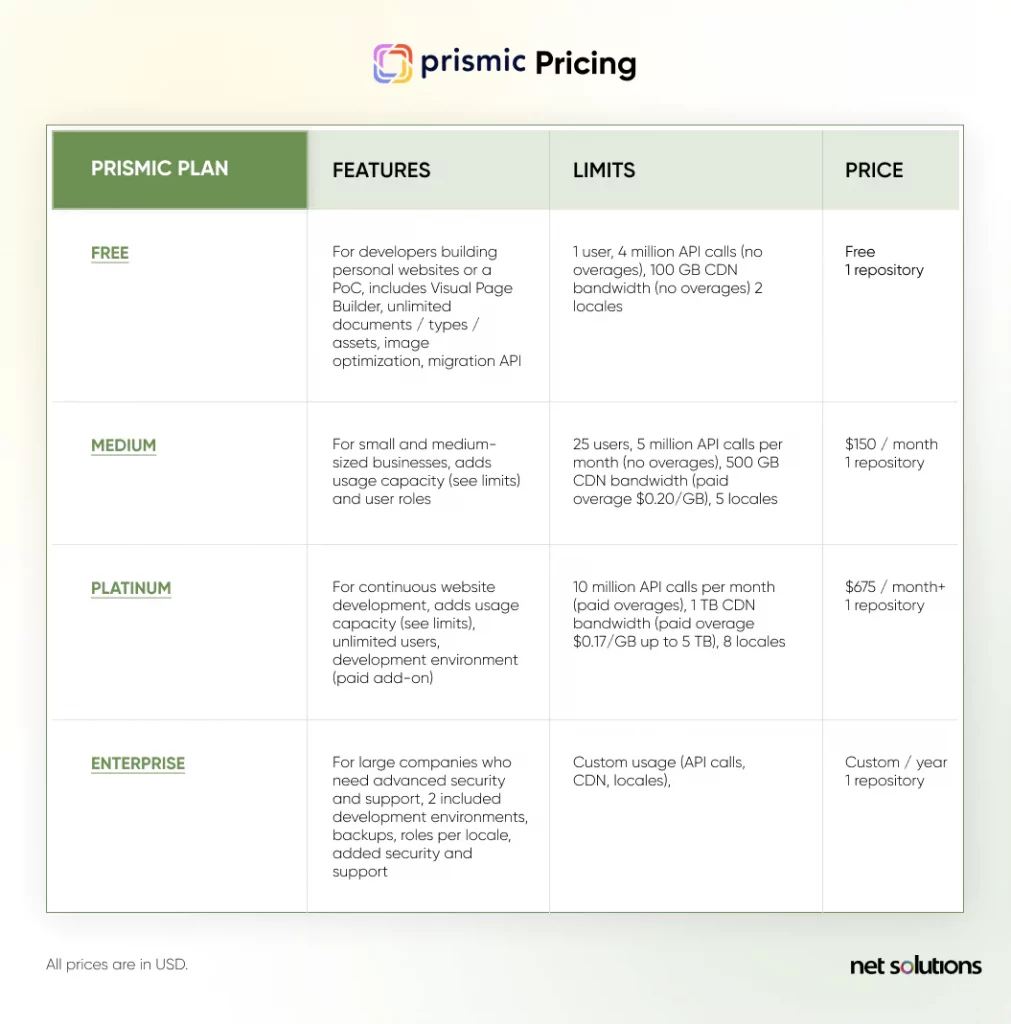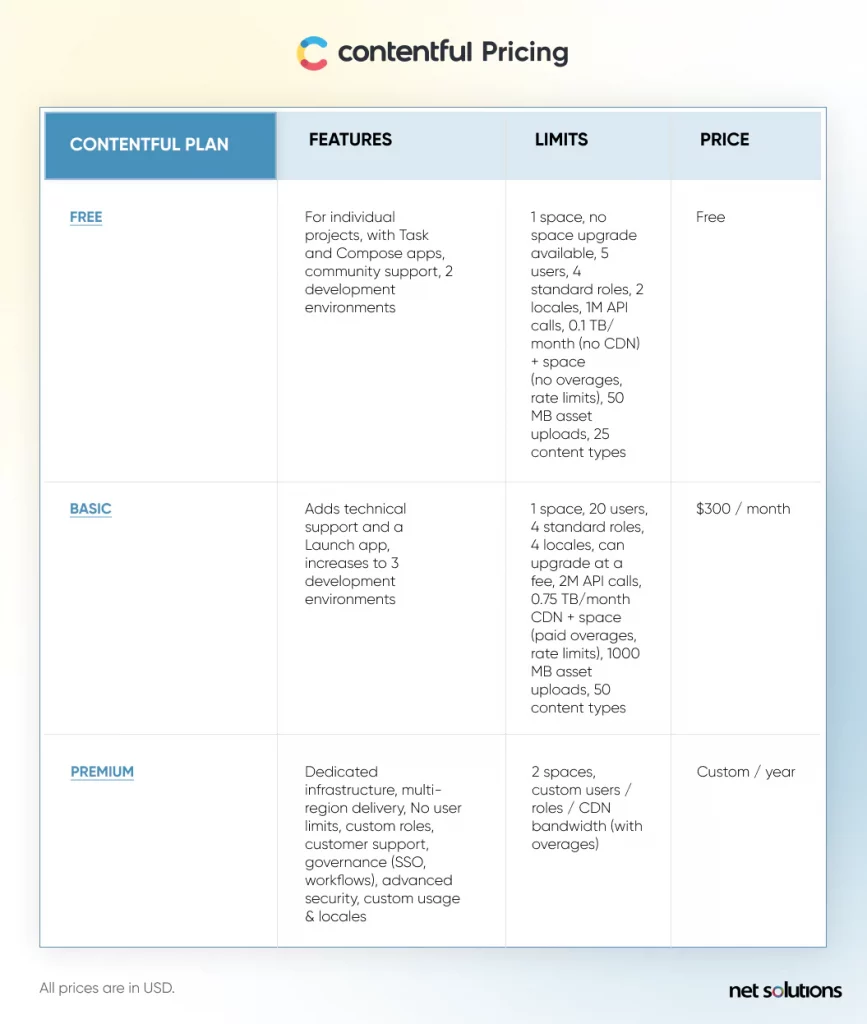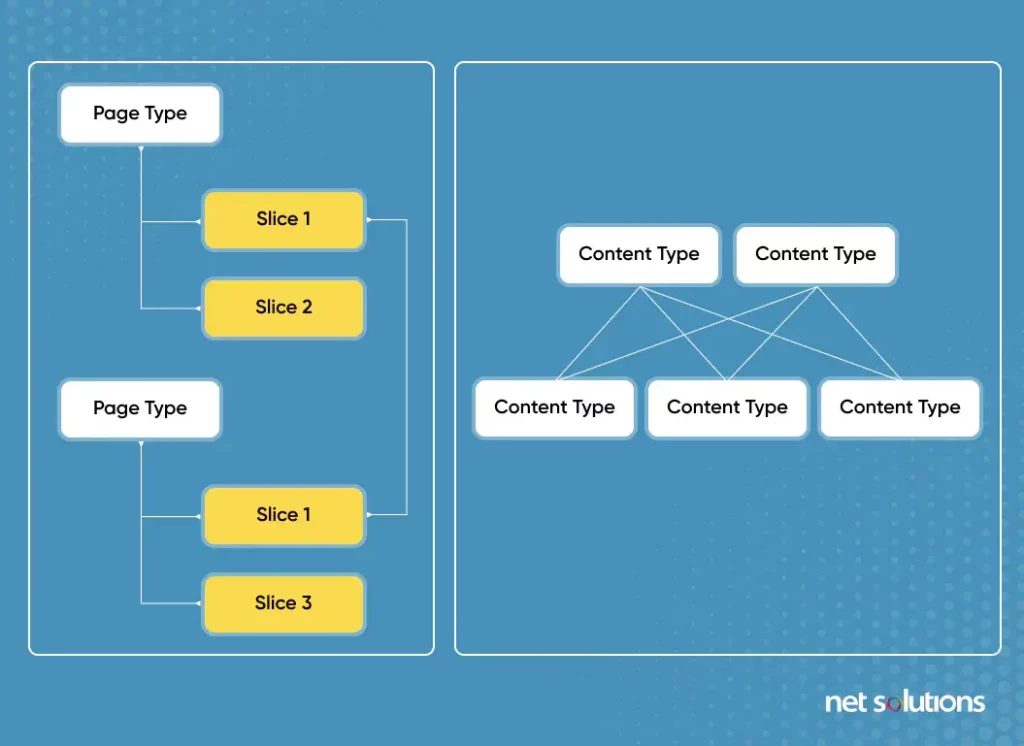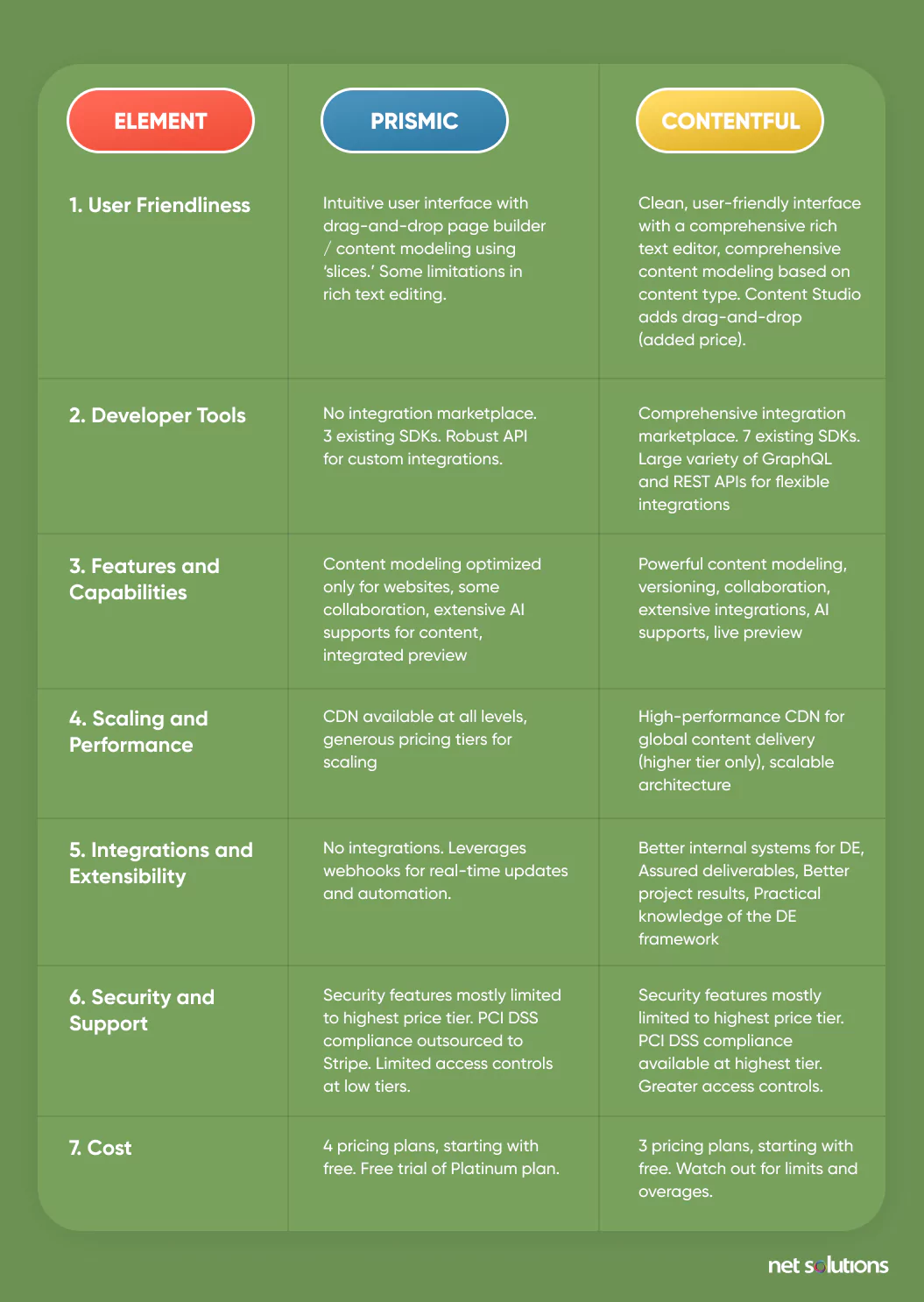The main difference between Prismic and Contentful is scope: Prismic focuses exclusively on websites, while Contentful also supports eCommerce and applications.
In this guide, you will find a full comparison between these platforms, including an analysis of the following:
- User-friendliness
- Features and capabilities
- The ability to support omnichannel delivery
- Scaling and performance
- Integrations and extensibility
- Security and support
- Platform cost
In 2023, there were 26.5 million eCommerce sites on the web, and 71% of global businesses have a website. Staying relevant in the competition is not easy. If you are looking to build or redesign your eCommerce site or website today, you or your organization might be considering a headless content management system (CMS) such as Prismic or Contentful (read What is Headless CMS).
Disclaimer: The information below is accurate as of July 4, 2024.
Before we head into this topic, first we’ll begin by pointing you to some starter resources that describe what content management system (CMS), how SaaS works, and also the difference between a headless CMS vs traditional CMS. Both Prismic and Contentful are headless CMS, that separate the front and back-end to optimize how content is delivered across infinite digital channels.
Let’s look at each platform in greater detail to help you analyze features and benefits that meet your project needs.
Prismic Overview
Prismic (Prismic.io) is a headless CMS specifically optimized to develop web pages for Next.js, Nuxt, and SvelteKit websites and make it easy to reuse page sections (‘slices’) across sites.
Prismic is ideally suited for:
- Websites (particularly multiple sites per brand)
- Blogs
- Content for eCommerce (limited)
- Content pushed to apps (e.g. landing pages)
Key features of Prismic
Prismic is an easy-to-use website builder that puts content at the center to help deliver it to multiple front-end devices and channels.
- Visual Page Builder: The page builder helps build out a new page as intuitively as you would a slide deck, adding ‘slices’ and dragging-and-dropping them around the page with a live preview alongside.
- Slices: These customizable page sections (e.g., content blocks) make it easy to reuse components while ensuring brand consistency. Slices are stored per type (variation options of a slice type) with large screenshots to make them easy to reuse.
- Preview: Preview is natively embedded in the content interface, demonstrating immediate feedback to content creation.
- Localization: Leverages locales to manage multilingual content (note that locales limited at lower price tiers). Toggle with each locale directly on the page to make content management more efficient. Number of supported languages is not available.
- Prismic AI: Prismic uses artificial intelligence to help you decide on slices to match your stated goals or to fill out slices using “Iterate with AI” features. AI can also smart-match large bulks of copy from Google Docs or Notion to appropriate fields.
Why choose Prismic?
Here are some of the reasons developers, content teams, and marketers love working with Prismic to ensure brand consistency across multiple websites:
Speedy and effective content delivery
The Prismic API is backed by a CDN to ensure content is delivered quickly for all price tiers.
Simplified image administration
The Media Library is a shared space for images and other media assets to help make it fast to put together new pages. Integration with Unsplash makes it easy to pull in free stock images. Images are dynamically optimized with Imgix. As a bonus, the CDN is available even at the free level, helping optimize image delivery for all users.
Enhanced developer experience
Prismic supports modern web frameworks and leverages dedicated SDKs built on Next.js, Nuxt and SvelteKit’s best features (more planned). The local development tool, Slice Machine, helps create content faster, with auto-generated component structure, code snippets, visual modeling and built-in TypeScript.
Streamlined content creation and collaboration
Prismic has spent a good deal of time optimizing its interface to be intuitive, leveraging embedded preview, large ‘screenshots’ of each slice and drag-and-drop capabilities to move slices around on the page. It’s intuitive to fill in fields (particularly with the help of AI and the ability to bulk paste content and have it auto-populate fields) and to toggle design options within brand guidelines. Preview links can help get team buy-in and approvals, even for non-Prismic users.
Downsides of Prismic
Although Prismic has benefits for all users, it is specifically marketing to developers to make it easy to scale content. This results in the following:
Learning curve
Prismic creates a rigid content model and leverages the unusual language to create ‘slices’ (vs content blocks), so developers will have a learning curve initially to avoid creating options that are limiting and difficult to undo (e.g. transitioning from products to product bundles). A look at community support shows that there could be some initial learning curves associated with managing locales and languages.
Financial considerations
While Prismic offers three paid price plans, the locale limitations at the lower two price tiers make it less useful to fulfill the potential of a headless CMS. Further, while API limits are generous at lower tiers, large organizations will likely end up on the Custom tier. When examining prices, consider the cost of the entire tech stack (e.g. if you need to separately manage eCommerce). As an incentive, Prismic does give you a 30 day option to try their Platinum level.
Limited features
Prismic is lacking some standard WYSIWYG features in its text editor (e.g. blockquotes), support for relative links, or support for strong multi-factor authentication (unless you’re at the highest pricing tier). Furthermore, not all users appreciate the lack of required fields, which could create some brand inconsistencies. Prismic also lacks a marketplace of integrations.
Prismic pricing
The following table outlines the four Prismic pricing plans:

Note: All prices are in USD based upon annual pricing.
Contentful Overview
What is Contentful? A modern content management system (CMS) designed to help brands, business owners, digital marketers and developers to manage content and scale it across multiple channels and devices.
Contentful is ideally suited for:
- Websites (particularly those with a Global focus)
- Mobile apps
- Knowledge bases or portals
- Interactive guides
- eCommerce
Key features of Contentful
Contentful is known for:
- Content Studio: Leverages patterns, design tokens and a drag-and-drop canvas to create experiences faster and reduce developer burden. Content Studio is backed by controls to ensure brand consistency and integrity across channels and markets. Paid add-on product.
- AI: Artificial intelligence integrated into both the Platform and Studio to help build content models, streamline content development, translate content, and automate workflows.
- Contentful Ecosystem: includes a rich Marketplace and an Contentful App Framework to build web apps
- Proprietary built-in apps: Task, Compose, Launch apps help deliver content faster
- Detailed Content Modeling: The content structure supports complex content modeling that, while time consuming, makes content reusable in a myriad of ways.
- Localization: Multi-region delivery (Premium plans) via Locales, AI and third-party integrations to support 100+ languages.
For a more detailed look at Contentful, read our in-depth analysis of What is Contentful.
Why choose Contentful?
Why do developers and website owners love Contentful? Let’s have a look at some of the benefits stated:
Versatility and personalization
Contentful can be used to create a variety of digital experiences (web, mobile, composable commerce) and supports personalization, both of the user interface as well as the delivery of interactive and personalized shopping experiences.
Extensive APIs for streamlined content management
Contentful is considered API-first, with the following eCommerce APIs (based on REST and GraphQL) supported:
- Content Delivery API (CDA) to send content to display
- Content Management API to create or update content
- Content Preview API (CPA) to retrieve unpublished content
- Images API to retrieve and/or transform images
- GraphQL API for Content to retrieve published and unpublished content using GraphQL
- User Management API to manage users
- SCIM API to manage memberships and teams
Documentation and resources for developers
Developers can choose the frontend(s) of choice leveraging APIs and software development kits (SDKs) for Java, JavaScript, Python, PHP, .NET, Objective-C and Ruby. Community support is available on Discord where you can join in many discussions and there are extensive resources for developers.
Scalable
Has recognized capacity to scale and maintain performance (Fastly, CloudFront) for demanding global brands. You can view performance and uptime here.
Security
Contentful data centers are ISO 27001 compliant, support encryption, and include firewall and threat detection. Contentful backs up data and includes brute force protection on all spaces. Additional security features (SSO, custom domains, static webhook IPS, reporting, PCI DSS compliance) are available at higher pierce tiers.
SEO
Contentful supports SEO metadata (alt text, page keywords) customization during the data model, with other SEO support via integrations. Refer to the Contentful SEO guide.
Collaboration
Contentful supports multiple users (# depending on tier) to work on content simultaneously with versioning support and rollbacks. Contentful leverages webhooks and automation for content changes and supports custom roles (at premium) for security.
Want to know more about Contentful? Read our in-depth review of Contentful.
Read MoreDownsides of Contentful
Every platform will have considerations against it, including:
Learning curve
There can be a learning curve for both technical and non-technical users (e.g. content editors), particularly during set-up. New tools such as the Content Studio are helping to ease the learning curve for non-technical users.
Financial considerations
The Contentful free plan is limited, lacking support for large user groups, content types, security features, and development environments. Further, the limits on the plans (e.g. API calls, CDN usage, asset uploads) can result in costly overages or rate limits, so Contentful quickly becomes most relevant at its top tier pricing.
Complexities in content preview
Contentful offers a lot of choice: which content types can be previewed, preview customization as well as localization preview, but sometimes too much choice is actually confusing. Live preview can help reduce complexity (vs preview in new tab).
Contentful Pricing
The following table outlines Contentful pricing plans:

Prismic vs Contentful: Features
Contentful content models support content types that can be reused across a variety of use cases (commerce, websites, apps), while Prismic’s content model is website-specific, leveraging page types and page sections (‘slices’) that make new web content or websites easy to spin off. This scope goes right to the core of how content is modeled.

Prismic vs. Contentful: Features
Let’s take a closer look to answer what are the key features of Prismic compared to Contentful and vice versa?
Sure, here’s a comparison table between Prismic and Contentful based on the specified elements:

What are the key features of Prismic?
In summary, here are some things to note about Prismic:
- Headless, API-first CMS
- Slices to organize content
- Prismic AI
- Live Preview
- Visual Page Builder
What are the key features of Contentful?
In summary, here are things you need to know about Contentful:
- Headless, API-first CMS
- Leverages a flexible, detailed content model
- Rich text editor and new Content Studio
- Powerful automations and AI
- Strong marketplace for integrations
Prismic vs Contentful: What Users Have to Say
In this unbiased comparison of Contentful vs Prismic, we will share some reviews from the peer-to-peer review site G2.
What do users have to say about Prismic?
Prismic has 186 reviews on G2 and 4.5 out of 5 stars overall.
Pros:
“Prismic.io has revolutionized our content creation process with its intuitive interface and robust features. The ability to customize pages allows us to provide the type of experience [sic] we want, whether crafting compelling blog posts or designing product pages.” – Computer Software User
“We’ve been working with Prismic for years now, since the very early stages of slices and Slice machine. We love their content principles and philosophies, the experience for our development and content editing teams is the best. Structuring/maintaining our content with Prismic gives us many, many possibilities depending on the scale of every single project and client. Usually clients migrate from some older CMS and have a very easy onboarding to start creating their site!
Slices and variations are game changers, as is their new page builder, migration API, and we love and test every new feature as they come!
We’ve always gotten good responses from their support, mostly through community forums and sometimes through ticket requests.
Overall, a great, easy experience.” – Javier G.
“I’m highly impressed with this CMS! It offers fantastic features like SliceZone, simplifying customization for my team. Plus, the pricing is incredibly reasonable, making it a great value for us.” – Shubham J.
Cons:
“Adding more pre-built themes would make the process easier, as some projects don’t require starting from scratch. Increasing the number of demo themes would save time and effort” – Shubham J.
“Prismic is comprehensive, but it lacks nested list functionalities, which would be beneficial for organizing content more hierarchically. It’s a feature that would round out the content management capabilities nicely.” – Bret S.
“Usability is pretty low. Searching in platform is next to impossible.” – Computer Software User
What do users have to say about Contentful?
Contentful has 298 reviews on G2 and 4 out of 5 stars overall.
Pros:
“Contentful is a cloud-based service, eliminating the need for users to manage infrastructure and ensuring high availability.” – Rexford A.
“- Contentful can act as source of truth for contents for whole online shop
– There is Locale support which allows having content in multiple languages
– Third party apps are easy to install in contentful
– Its very easy to create content models that suits the needs from the Contentful Web UI
– Unpublished contents can be accessed using the preview api
– Content models changes can be experimented in different environments” – Sports shop user
“As a content manager, I’ve worked with other CMS systems like WordPress, but Contentful is by far the easiest to use. The interface is pleasant, and I enjoy creating unique strictures [sic] for each webpage or email. I’m not a developer whatsoever, and I found it really easy to navigate and learn.” – Gabriela R.
Cons:
“While the developer-facing features are top-notch, the actual content authoring experience is frankly sub-par, particularly for an enterprise oriented platform like this.
There are frankly no collaboration features to speak of, and it’s too easy for multiple authors to accidentally overwrite each others’ changes. Commenting can only be done a field level (so if the field is, say, a very long textarea, it’s not very useful).
Many features have UX complexities that make sense from a database POV, but feel clunky from an author POV. Being able to completely customize the editing interface is frequently touted as the jewel in their crown – but we found that even for simple things (e.g. allowing authors to define a custom HTML attribute for links) you’ll end up having to cut a completely custom WYSIWYG editor plugin from scratch.
The sales team could only offer custom development services from their partner agencies as a solution – and so it was difficult to see the ROI on spending five figures for a licence for software we’d have to spend six figures on to develop all the missing features.“ – Oskari G.
“I wish it was easier to change back to a previous version of certain content. This feature would really allow for easier mistake handling when changes needed to be made quickly.” – Education user
“The flexibility can be daunting for initial setup and those unfamiliar.” – John B.
Final Thoughts
If you’re a business owner or marketer looking to create a new website or streamline how you manage a large, constantly updating website or multiple websites for one brand, here’s what you need to know:
What is Prismic best for?
Prismic is best for websites of all sizes, particularly for large, constantly updating website or multiple websites for one brand.
What is Contentful best for?
Contentful is designed for omni-everything, delivering multi-brand and omnichannel user experiences for websites, apps or portals large and small.
If you would like further guidance on how to choose between Prismic and Contentful, or a more thorough look at all your headless CMS options, Net Solutions can help. Net Solutions offers Custom eCommerce Development Services to help you design, build and optimize your digital offerings using a variety of the latest technologies.
Net Solutions is a proud partner with Contentful, offering vast experience in web development and developing headless CMS platforms with specialized Contentful development services.



